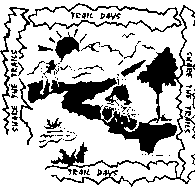The Effective CyclingTM Notebook
typically deals with the skills and knowledge necessary for bicycling on the road. This
installment, however, focuses on recreational paths and trails, which have become quite
popular with novice cyclists, families, and casual, recreational riders. As a result,
trails have become very congested and safety is a major issue. Whether bicycling, walking,
or jogging, if you follow the same rules as everyone else you will have a safer, more
enjoyable time.
It is important to remember that trails have engineering and design limitations that
require you to ride differently than you would on the road. If your preferred speed or
style of cycling is inappropriate for trail riding, look for alternative routes better
suited to your needs.
BE COURTEOUS. All trail users, including bicyclists, joggers, walkers, and wheelchair
users, should be respectful of other users, regardless of their mode of travel, speed,
or skill level.
GIVE AN AUDIBLE SIGNAL WHEN PASSING. Give a clear signal when passing. This signal may
be a bell, horn or voice. Warn in advance so that you have time to maneuver if necessary.
"Passing on your left" is the most common signal used to alert other users of your approach.
YIELD WHEN ENTERING and CROSSING OTHER TRAILS. When entering or crossing a trail at trail
intersections, yield to traffic on the cross trail or road. This is often the most dangerous
point on a trail.
KEEP RIGHT. Stay as close to the right side of the trail as is safe, except when passing
another user.
PASS ON LEFT. Pass others, going your direction, on their left. Look ahead and behind to
make sure the lane is clear before pulling out. Pass with ample separation. Do not move
back to the right until safely passed. (Allow more distance than you think is needed.)
Fast moving users are responsible for yielding to slower moving ones.

BE PREDICTABLE. Walk and ride straight. Indicate when you are turning. Warn other trail
users of your intentions.
USE LIGHTS AT NIGHT. If the trail is open and you are using it between dusk and dawn
you must be equipped with lights. Bikes need a white front light and a red rear light
or reflector. Reflectors (or reflective clothing) are no help if there is no source of
light.
DO NOT BLOCK THE TRAIL. When riding in a group, use no more than half the trail. Don't
be a trail hog. On many trails with heavy use, this means that all users will need to
stay single file. And if you stop to regroup, always do it off the trail.
NO ALCOHOL and DRUGS. On trails, as on the road, you often need to react quickly. Do not
use the trail when under the influence of alcohol or drugs. Not only is it unsafe, it is
against the law to operate a bicycle when under the influence.
CLEAN UP LITTER. Do not leave glass, paper, cans, or any other debris along the trail. If
you drop something, please pick it up and carry it until you find a litter receptacle. Go
the extra milepack out more trash than you bring in.
Reprinted with permission from the Ohio Bicycle Advisory Council.
Reprinted from "Bicycle USA", magazine of the League of American
Bicyclists, Nov/Dec 1994.
For more information about the League of American Bicyclists, visit
their web site, www.bikeleague.org,
or e-mail them at bikeleague@aol.com.
|